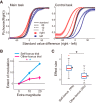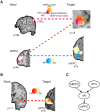Computing Social Value Conversion in the Human Brain
- PMID: 31000587
- PMCID: PMC6595950
- DOI: 10.1523/JNEUROSCI.3117-18.2019
Computing Social Value Conversion in the Human Brain
Abstract
Social signals play powerful roles in shaping self-oriented reward valuation and decision making. These signals activate social and valuation/decision areas, but the core computation for their integration into the self-oriented decision machinery remains unclear. Here, we study how a fundamental social signal, social value (others' reward value), is converted into self-oriented decision making in the human brain. Using behavioral analysis, modeling, and neuroimaging, we show three-stage processing of social value conversion from the offer to the effective value and then to the final decision value. First, a value of others' bonus on offer, called offered value, was encoded uniquely in the right temporoparietal junction (rTPJ) and also in the left dorsolateral prefrontal cortex (ldlPFC), which is commonly activated by offered self-bonus value. The effective value, an intermediate value representing the effective influence of the offer on the decision, was represented in the right anterior insula (rAI), and the final decision value was encoded in the medial prefrontal cortex (mPFC). Second, using psychophysiological interaction and dynamic causal modeling analyses, we demonstrated three-stage feedforward processing from the rTPJ and ldPFC to the rAI and then from rAI to the mPFC. Further, we showed that these characteristics of social conversion underlie distinct sociobehavioral phenotypes. We demonstrate that the variability in the conversion underlies the difference between prosocial and selfish subjects, as seen from the differential strength of the rAI and ldlPFC coupling to the mPFC responses, respectively. Together, these findings identified fundamental neural computation processes for social value conversion underlying complex social decision making behaviors.SIGNIFICANCE STATEMENT In daily life, we make decisions based on self-interest, but also in consideration for others' status. These social influences modulate valuation and decision signals in the brain, suggesting a fundamental process called value conversion that translates social information into self-referenced decisions. However, little is known about the conversion process and its underlying brain mechanisms. We investigated value conversion using human fMRI with computational modeling and found three essential stages in a progressive brain circuit from social to empathic and decision areas. Interestingly, the brain mechanism of conversion differed between prosocial and individualistic subjects. These findings reveal how the brain processes and merges social information into the elemental flow of self-interested decision making.
Keywords: computational; decision making; fMRI; social preference; social value orientation; value.
Copyright © 2019 the authors.
Figures








Similar articles
-
Decision-Making with Predictions of Others' Likely and Unlikely Choices in the Human Brain.J Neurosci. 2024 Sep 11;44(37):e2236232024. doi: 10.1523/JNEUROSCI.2236-23.2024. J Neurosci. 2024. PMID: 39179384 Free PMC article.
-
Independent Neural Computation of Value from Other People's Confidence.J Neurosci. 2017 Jan 18;37(3):673-684. doi: 10.1523/JNEUROSCI.4490-15.2016. J Neurosci. 2017. PMID: 28100748 Free PMC article.
-
Social stress enhances intuitive prosocial behavior in males while disrupting self-reward processing: Evidence from behavioral, computational, and neuroimaging studies.Neuroimage. 2025 Jul 15;315:121273. doi: 10.1016/j.neuroimage.2025.121273. Epub 2025 May 15. Neuroimage. 2025. PMID: 40381894
-
[Social decision-making and theoretical neuroscience: prospects for human sciences and computational psychiatry].Brain Nerve. 2013 Aug;65(8):973-82. Brain Nerve. 2013. PMID: 23917500 Review. Japanese.
-
Breaking human social decision making into multiple components and then putting them together again.Cortex. 2020 Jun;127:221-230. doi: 10.1016/j.cortex.2020.02.014. Epub 2020 Mar 9. Cortex. 2020. PMID: 32224320 Free PMC article. Review.
Cited by
-
Psychotherapy in pain management: New viewpoints and treatment targets based on a brain theory.AIMS Neurosci. 2020 Jul 14;7(3):194-207. doi: 10.3934/Neuroscience.2020013. eCollection 2020. AIMS Neurosci. 2020. PMID: 32995484 Free PMC article.
-
Links Between the Neurobiology of Oxytocin and Human Musicality.Front Hum Neurosci. 2020 Aug 26;14:350. doi: 10.3389/fnhum.2020.00350. eCollection 2020. Front Hum Neurosci. 2020. PMID: 33005139 Free PMC article. Review.
-
Learning under social versus nonsocial uncertainty: A meta-analytic approach.Hum Brain Mapp. 2022 Sep;43(13):4185-4206. doi: 10.1002/hbm.25948. Epub 2022 May 27. Hum Brain Mapp. 2022. PMID: 35620870 Free PMC article.
-
Functional specialization within the inferior parietal lobes across cognitive domains.Elife. 2021 Mar 2;10:e63591. doi: 10.7554/eLife.63591. Elife. 2021. PMID: 33650486 Free PMC article.
-
Intermittent Theta Burst Stimulation (iTBS) as an Optimal Treatment for Schizophrenia Risk Decision: an ERSP Study.Front Psychiatry. 2021 May 10;12:594102. doi: 10.3389/fpsyt.2021.594102. eCollection 2021. Front Psychiatry. 2021. PMID: 34040546 Free PMC article.
References
-
- Adèr HJ, Mellenbergh GJ, Hand DJ (2008) Advising on research methods: a consultant's companion: Huizen, The Netherlands: Johannes van Kessel Publishing.
Publication types
MeSH terms
LinkOut - more resources
Full Text Sources
